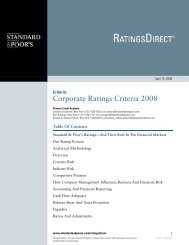European Infrastructure Finance Yearbook - Investing In Bonds ...
European Infrastructure Finance Yearbook - Investing In Bonds ...
European Infrastructure Finance Yearbook - Investing In Bonds ...
Create successful ePaper yourself
Turn your PDF publications into a flip-book with our unique Google optimized e-Paper software.
Accounting<br />
BAA changed its reporting date to Dec. 31<br />
(previously March 31) to align with Grupo<br />
Ferrovial S.A., its ultimate majority shareholder.<br />
Auditors issued an unqualified audit report for<br />
the last fiscal period.<br />
The consolidated financial statements for BAA<br />
Ltd. (formerly BAA PLC) are prepared in<br />
accordance with IFRS and under the historical<br />
cost convention, with the exception of investment<br />
properties, available-for-sale assets, derivative<br />
financial instruments, and financial liabilities that<br />
qualify as hedged items under a fair value hedge<br />
accounting system.<br />
During the course of 2006, BAA changed its<br />
accounting treatment for joint venture entities to<br />
proportionately consolidate the financial<br />
performance for the reporting period and the<br />
financial position at Dec. 31, 2006 (previously<br />
joint venture entities were equity accounted).<br />
This change in policy has no impact on net profit<br />
or reserves.<br />
The financial information presented in this<br />
report is based on the segregation of the fourth<br />
quarter of the fiscal year ended March 2006 from<br />
the financial report for the nine months to<br />
December 2006, and reflects the balance sheet at<br />
December 2006. Comparability with the fiscal<br />
year ended March 2006 must be considered in<br />
view of the three-month crossover.<br />
The main adjustments to the company’s<br />
reported debt figures concern leases,<br />
postretirement obligations (£192 million), and<br />
contingent liabilities.<br />
BAA has changed the disclosure of its lease<br />
obligations under IFRS. Comparing the previous<br />
2004/2005 accounts with the 2005/2006<br />
accounts, the amounts payable in 2005/2006 did<br />
not correlate to the previous disclosure or the<br />
actual charge in the accounts. The accounts for<br />
the year to December 2006 (with restated figures<br />
at March 2006) show a large lease liability. For<br />
comparison purposes, the adjustment of future<br />
lease obligations for the net present value at 6%<br />
has also been made for the years ended March<br />
2005 and March 2006.<br />
Our adjustments to operating income (before<br />
D&A) and EBITDA (see table 1 on previous<br />
page) reflect three key components: the operating<br />
income contribution for three months (£216<br />
million) less the gain on investments (£206<br />
STANDARD & POOR’S EUROPEAN INFRASTRUCTURE FINANCE YEARBOOK<br />
TRANSPORTATION INFRASTRUCTURE<br />
million) plus the derivatives losses (£21 million)<br />
recognized in operating income. The adjustments<br />
to EBIT reflect the same items along with three<br />
months of depreciation (£81 million) and interest<br />
income (£10 million). The adjustments to interest<br />
expense, cash flow from operations, funds from<br />
operations, and capital expenditure relate entirely<br />
to the three-month pro forma adjustment.<br />
Corporate governance/Risk tolerance/<br />
Financial policies<br />
ADIL’s strategy and intention is to migrate<br />
existing bondholders into an investment-grade<br />
ring-fenced entity backed by BAA’s three<br />
designated airports. BAA’s other airports in the<br />
U.K. (Southampton, Aberdeen, Glasgow, and<br />
Edinburgh) will remain outside of the ringfence<br />
and are expected to be financed on a standalone<br />
basis.<br />
We expect the future ring-fenced structure<br />
financing to be supported by:<br />
• A strong overall covenant package;<br />
•Limitations on additional debt and business<br />
activities, such as a rating confirmation<br />
requirement for acquisitions above certain<br />
thresholds (the latter creating certainty that<br />
the revenue profile will not change);<br />
• Restrictions on upstream distributions<br />
outside the ring-fence;<br />
•Likely achievable fixed and floating charges<br />
on the assets of the three designated<br />
airports; and<br />
•The stability provided by BAA’s designated<br />
airports business.<br />
BAA’s main financial policy objectives are:<br />
• To maintain a minimum of 70% of existing<br />
debt on fixed rates.<br />
• To use foreign currency forward contracts to<br />
hedge capital expenditure in foreign<br />
currency once a project is certain to go<br />
ahead. At December 2006, there were no<br />
significant unmatched exposures.<br />
• To ensure that the company is not exposed<br />
to excessive refinancing risk in any one year.<br />
<strong>In</strong> addition:<br />
•Covenants are standardized wherever<br />
possible and are monitored on an ongoing<br />
basis. BAA continues to comply with all<br />
borrowing obligations and financial<br />
covenants.<br />
NOVEMBER 2007 ■ 63



